
Hong Kong Lepidopterists' Society Events & Activities
<>HKLG Trip to Nan Kun Shan, Guangdong Province, China
28th to 31st March 1998
by James J. Young

The trip to Nan Kun Shan, Guangdong was planned as early as in May last year. It was hoped that the complete life history of various single brooded butterflies found in Nan Kun Shan could be observed particularly their ovipositing and mating behaviours. The butterflies in mind were Pathysa agetes and Pazala eurous of the Papilionidae family. They only fly in the early Spring for about two weeks each year.

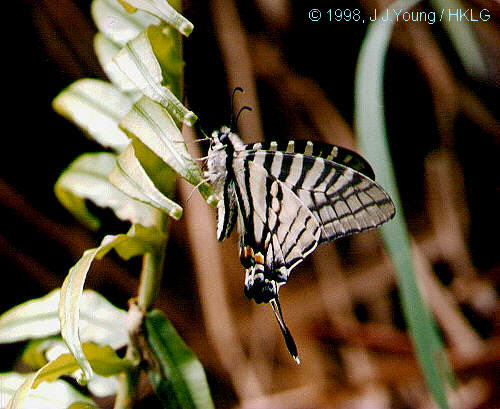
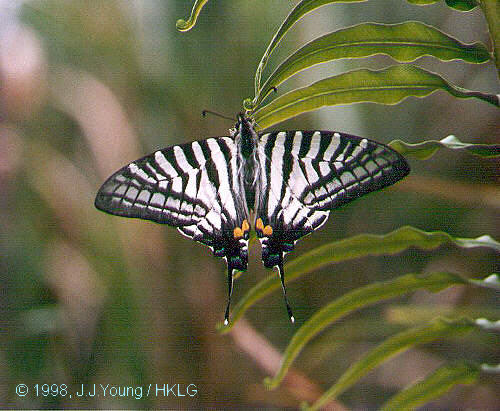
Pazala eurous. Nan Kun Shan.
Nan Kun Shan is about 105km northeast of Guangzhou. It is said to be a nature reserve but the present status is unknown. It is part of the Nan Ling mountain range surrounding the northern part of the Guangdong Province. Even though it has peaks rising to over 1200m in height, it does not have those high altitude butterflies found in the northern part of the Province, as at the Nan Ling National Reserve. However, there are many interesting butterflies in the vicinity including Stiboges nymphidia of the Riodinidae family, a white tiny riodinid commonly found in late April to early May each year.

On the morning of 28th March, 1998, a party of four from the HKLG left Hong Kong for Guangzhou by express bus from Wan Chai pier. After checking in the hotel in Guangzhou in the afternoon, the party went immediately to the Guangzhou Children Palace, (school for extra-curriculum) to meet Chen Xi Chang who would lead the group to Nan Kun Shan. After properly introduced, the group went for books hunting in Guangzhou namely entomological and flora books. They are very cheap in comparison with the standard of living in Hong Kong and are generally the only sources of reference for southern China. The cost of the 1st volume of Guangdong flora by Chen can be bought for RMB9.00 or equivalent to US1.00 for a book of 600 pages with drawings of most of the described plants of the southern China.

After a good night sleep, we were greeted by the head of the Guangzhou Children Palace in the morning at the hotel and who insisted that we should go to see their the future recreational site of the school at Conghua where a butterfly garden is also planned. Conghua is a place famous for its hot springs.

We were blessed with blue skies and the temperature was abnormally high around 26 to 27įC (79-81įF). The journey took us about an hour to the proposed recreational site at Conghua on the highway. The place was well located next to a river and the view was quite nice in this part of the Conghua. We then left for Nan Kun Shan after a while. The roads to Nan Kun Shan were all paved and we arrived at Zhung Ping, the centre of Nan Kun Shan at noon. After a good lunch at the hotel costing RMB40.00 per night with all modern amenities, we immediately headed off to the nearby small electricity generating house near a river hoping to find Chilasa agestor and C. epycides which feed on camphor trees.


Chilasa agestor. Nan Kun Shan.
Many butterflies were seen flying but we were disappointed not to find the two Chilasa at this spot as they were found to be quite abundance in last year. We saw a few freshly emerged Mandarinia regalis of the Satyrinae sub-family (Nymphalidae). They have brilliant blue on the forewings and may be confused in flight with some of the Arhopala species (Lycaenidae family).
On strolling around the road side, a strong robust nymph flew pass myself and I immediately realized it was the flight of an Euthalia sp. It came down to the ground to feed and it was identified as Euthalia irrubescens with no record of its existence in the Guangdong province. It so happened that David was holding Chenís net nearby me and without hesitation, I grasped the net and caught the first ever recorded Euthalia irrubescens in Guangdong. The specimen is now housed in the Guangzhou Children Palace which is looked after by Chen. Chenís collection is the most representative of the Guangdong species.

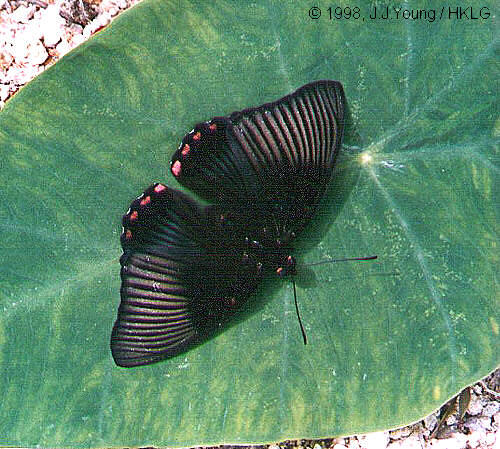
Euthalia irrubescens. Nan Kun Shan.
We did see a few Pazala euroa flying along streams but they did not come close or settle down for a nice photograph. Time was running late and we stopped at around the generator house for a while for taking photographs of some large saturnid moths hanging on the wall before we headed back to the hotel. The next morning we went the Tin Tang Ding, the so called Heavenly Peak. At about 1238m above sea level this is the highest point in Nan Kun Shan. We found again many butterflies flying including Atrophaneura aidonea, Papilio paris, Chilasa agestor, Graphium cloanthus and of course Pazala eurous. We did not see any Pathysa agetes nor we found any immature stages of the butterfly on its foodplant, Fissistigma oldhamii which is very common in the vicinity. The group was extremely tired when we returned to the hotel in the afternoon.
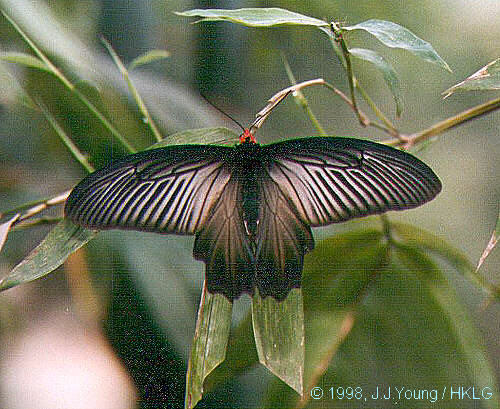 |
Atrophaeneura aidonea (female) |
The next morning we headed back to Guangzhou by a local lorry and said farewell to our friend Chen before returning by express bus to Shenzhen and then onwards by train to Hong Kong.
The trip was enjoyed by all members of the group and promised to return soon.
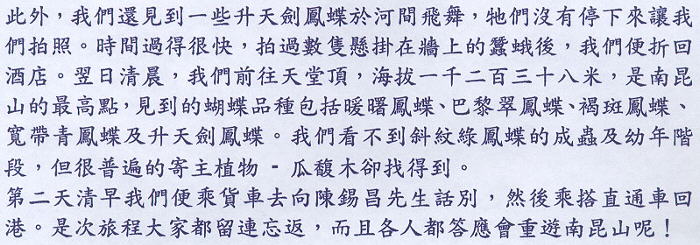
Taxonomic note
by Roger Kendrick
The nomenclature of the genera and higher taxa for butterflies in China is currently a matter of debate. The names of some species given above differ from those in Bascombe (1995). The table below gives the taxonomic status (after Bascombe, 1995) of the species mentioned in the text.
|
Papilionidae Papilioninae Graphini Graphium cloanthus (Westwood, 1841) Graphium (Pathysa) agetes (Westwood, 1843) Graphium (Pazala) eurous (Leech, 1893) Papilionini Papilio (Chilasa) agestor (G.R.Gray, 1831) Papilio (Chilasa) epicydes (Hewitson, 1864) Papilio paris Linnaeus, 1758 Troidini Atrophaeneura aidonea (Doubleday, 1845) °@ |
Lycaenidae Riodininae Stiboges nymphidia Butler 1876 Nymphalidae Limenitidinae Limenitidini (subtribe Euthaliiti) Euthalia irrubescens Gross Smith, 1893 Satyrinae Elymniini (subtribe Lethiti) Mandarinia regalis (Leech, 1889) °@ |